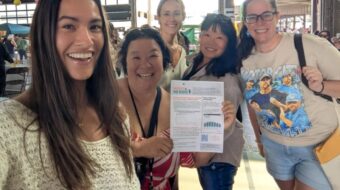
Presidential hopeful Elizabeth Warren recently made waves after she announced her idea to eliminate student loan debt and make all public colleges free. The plan would hypothetically cancel student loan debt for more than 95% of borrowers, and would entirely cancel student loan debt for more than 75% of Americans. The public reception has been quite positive, as might be expected, considering Americans now collectively owe more than $1.53 trillion in student loan debt.
Such a transformative policy, if it ever came to be, would drastically impact the daily life of millennials. With tuition and fees rising and good jobs becoming harder to find, student loan repayments are crushing their prospects for the future. Research suggests it takes an average of 19.7 years for the average four-year degree holder to pay off their loans in total. Millennial households with student loan debt have an average net worth of $29,087, compared with $114,376 for student loan-free households. They also have 46% less in their savings and checking accounts (median balance of $5,500 vs $10,180 for those without student loans).
According to the Federal Reserve Bank of New York, student debt “now comprises 69 percent of the debt side of their balance sheets” for an average 25- to 30-year-old. Which begs the question—How would eliminating student loan debt change the lives of a struggling generation?
People’s World talked to four college graduates about their experiences and what it would mean for their lives to be freed from student debt.
Abby Billups, 28, family support specialist—$48,000 of student loans

Abby Billups is a mother, a wife, and crisis responder for Chicago’s Citizens For Change (CCC), an organization that provides support and referral services for the families of homicide victims. “When someone dies, if they get taken to one of the hospitals in Chicago, I go to the scene to provide the family with resources,” says the 28-year-old Family Support Specialist.
Billups is also enlisted in the United States Army Reserves as a chaplain assistant. She says her work in the reserves is similar to her full-time job. “We respond to mental health crises and suicidal ideation,” she says. “Anytime a soldier is having a problem, we counsel them and connect them with services, which is why I took that job in the first place.”
Billups is a first-generation college student who aspires to be a social worker. After graduating in 2012 from the University of Illinois in Urbana-Champaign, Billups got a job as a case manager at the Association House of Chicago working on child welfare cases. While employed there, she realized she would eventually hit a ceiling in her line of work.
“I definitely need my master’s degree to move up…not just that, but I need to be clinically licensed if I want to do any type of clinical therapy.” Despite having over three years of casework experience and a work ethic that made her the go-to person at her former job, Billups was unable to get promoted without a higher degree. “Even though the supervisor had his master’s, he didn’t have the field experience,” she says, “I think that makes a huge difference, but either way you still need that piece of paper.”
Billups was previously enrolled in graduate school but had to drop out after two semesters. It quickly became overwhelming to split her time between school work and taking care of her infant son. Withdrawing, however, added an additional debt to her rising expenses. “I came out of undergrad with $30,000 in loans; the second time I came out with around $48,000, in addition to the fee that the school charged me for withdrawing past the deadline.”
Like many other Latino professionals, Billups says that she doesn’t see her communities represented in her line of work. “Once most social workers get their license, they stop working for nonprofits because they just don’t get paid enough.” The rising cost of higher education poses an issue for young academics of color—they can either chose to stay in a public service job and struggle with finances or accept a higher-paying position elsewhere. “There’s this huge need for mental health services on the south side of Chicago,” she reiterates, “but we just don’t have clinicians because we don’t get paid enough.”
Billups says that a legislative mandate to eliminate student loan debt would be a life changer and allow her to get her life back on track. “I’d have my credit score back, I’d invest and start saving—I really wish we had a house.”
Despite all the personal financial barriers she faces, Billups emphasizes the need to consider future generations as well. Above all else, she sees the push to eliminate student debt as a way to secure her son’s future. “I would invest in Noah’s education and start saving for him so that he doesn’t have to go through to what I went through.”
Dhara Shah, 29, Grad student—$80,000 of student loans

Dhara Shah was ecstatic when she was accepted to the School of Visual Arts in New York. The Chicago native spent ten years putting her biomedical engineering degree to use through community development and organizing work and was ready to pursue an MFA in Design for Social Innovation.
As an undergraduate student, Shah was fortunate enough to be awarded a four-year academic scholarship. Paired with the fact that she from a financially literate family—her father previously oversaw the financial aid process when her older brother attended college—Shah was able to graduate with only around $7,000 in student loans.
Shortly before applying to graduate school, Shah’s student loan debt was paid off in full. But now, the young former engineer is now approximately $70,000 back in the hole due to all the loans she has been forced to take on in order to attain her necessary master’s degree. Like many young professionals, graduate school was the only option for Shah to move up in her field of work. “I won’t be hired as a system designer in the social sphere without formal education to back it up—I need that piece of paper.”
Like many of her peers, Shah dreams of one day having a family, but the amount of debt she now owes places her in a compromising position. “I’m just really miserable, these loans have added so much stress to everything,” she says. “I’m getting married, and even thinking about planning for the wedding is overwhelming.” Studies have shown that millennials are not only getting married less than previous generations but also having fewer babies. These statistics are an indicator of the way in which financial insecurity is altering a generation’s choices.
One concern that Shah brought up was the fact that work in public service careers is often not well-rewarded. “The type of work I’m seeking to do won’t help me pay off these student loans,” she says, “I’m sucked into this cycle.” Furthermore, Shah says she grapples with the cost of school versus the quality of the education she is receiving. “I don’t feel like I’m getting $100,000 worth of education, I don’t feel like I’m getting my money’s worth.”
Regardless, the decision to ultimately attend graduate school came out of necessity. Shah aspires to co-create systems and policies that empower marginalized communities, and she is passionate about centering the voices of disenfranchised individuals through her work. “A lot of people in my situation would’ve just stayed an engineer,” she says, “but I was a terrible version of myself at my old job, I was so far away from the version of me who I wanted to me.”
Annie Dunbar, 31, independent researcher—$100,000 in student loans

Annie Dunbar took out her first student loan at 18-years-old. Dunbar is a first-generation college student who grew up in a single-parent home and was eager to pursue higher education. “I was set to be the first person in my family to attend college; I would have done anything to make that happen,” she says, “but the whole application process is so predatory.”
Dunbar speaks directly to the ways in which student loan companies enact deceptive and predatory lending practices. In recent years, companies like Navient have faced a torrent of lawsuits brought by the federal government and several states. In early 2017, the Consumer Financial Protection Bureau (CFPB) brought a federal case, which claimed Navient “systematically and illegally failed borrowers at every stage of repayment.”
Dunbar attended Simmons University, a private women’s undergraduate university in Boston, from 2006 to 2010. Although she excelled academically, Dunbar struggled to keep up with tuition payments and housing fees after her freshman year. Academic institutions often offer more financial assistance and scholarships to first-year students as a recruiting tool. Once a student enrolls, however, the financial aid typically declines in the years that follow, leaving upperclassmen high and dry as they work to complete their studies.
After graduation, Dunbar struggled to pay back the $50,000 student loan debt she was left with. The 31-year-old says that she has always held multiple jobs throughout her adult life. “My plan was to get a job after college,” she says. But like many millennials, Dunbar was entering the workforce in the aftermath of the greatest recession since the Great Depression. Job prospects were, to say the least, not so bright. After Dunbar was accepted to the University of Chicago for graduate school in 2013, she made the harrowing decision to take out additional loans in order to move from Boston to Chicago and attend the prestigious School of Social Service Administration. The additional degree ended up costing her another $50,000.
Now, four years after attaining her master’s degree, Dunbar is once again enrolled in school. She is currently more than $100,000 in debt and openly calls her acceptance into the Ph.D. program at the University of Denver a “financially terrible decision.” Nevertheless, Dunbar says she knows what she is getting into this time around. “It’s a nightmare to think that the only way to gain legitimacy in your field is by having an institution back that, but I know I have to go.”
The amount Dunbar currently pays back in federal student loans is the equivalent of her rent—money which she says would be better put to use in saving up for a car or a house. “I think people think it’s all frivolous things,” she says referencing the popular myth about excessive millennial spending habits. “We work super hard all the time and are told we complain too much, but I have only had one real vacation since I graduated college nine years ago,” she says.
Research suggests that student debt also plays a major role in racial wealth inequality. Studies show women hold nearly two-thirds of student loan debt, and black women graduate with the most debt of any group. “As a Black woman, I am making vastly less than my white counterparts,” says Dunbar, “so my debt weighs differently.”
Regardless of the financial barriers in her way, Dunbar hopes to someday own her own house and start a family. She remains optimistic that her continuous pursuit of higher education will be a long-term investment in the security of her future. In the meantime, Dunbar continues to invest in her community and devote time to causes that are important to her.
Jerico Domingo, 23, artist (they/them)—over $100,000 in student loans

Jerico Domingo is a multidisciplinary artist with a bachelor’s degree from the School of Art Insitute of Chicago (SAIC). They have been featured in exhibits throughout the country, including places like New York and Tennessee.
Domingo took an interest in art at an early age and was determined to attend an institution that would help them explore a wide-range of artforms outside of traditional practices. The program they were most invested in attending was at SAIC, which is affiliated with the Museum of Art Institute of Chicago and consistently ranked among the top art schools in the U.S.
Although Domingo was awarded a substantial scholarship, SAIC is reported to have one of the highest price tags of any private school in the nation, with tuition and fees coming out to $45,750 annually. “When I got my scholarship letter and it listed my financial awards, it seemed a lot,” they said. “But then you see the actual cost of tuition and you’re like, wow, this isn’t enough.” As a result of the high cost of attendance, a majority of the loans Domingo took out ended up being Parent PLUS Loans.
The Parent PLUS Loan is a federal student loan available to the parents of dependent undergraduate students. The Parent PLUS Loan offers a fixed 7.6% interest rate, which is generally higher than the rate for a private student loan, around 5.25 to 6 percent. The loan comes with an “origination fee,” and the applicant must have good credit history. Additionally, borrowers are expected to start repayment immediately after the loan is paid out rather than defer payments until they finish school.
Domingo says that although the cost was steep, they felt a certain obligation to pursue their artistic passion after all the sacrifices their parents made for them. “My immigrant mother came from the Philippines and worked her ass off so I could fulfill my dream,” they disclose. Although the student loans helped cover living expenses, Domingo got an additional job in order to pay for the numerous class expenditures, which they estimate amounted to $200 for each art assignment.
In the midst of undergrad, Domingo’s family also faced unexpected financial hardships after legal troubles arose. “When I was in high school, my family was really financially stable,” says Domingo, “then the summer of my senior year of college my mom got arrested and couldn’t get her job back as a nurse.” Although the charges were eventually dismissed, bills continued to pile up. In addition to the legal fees, Domingo’s mother also struggled to find work again. The sudden shift in household income made it difficult to keep up with student loan payments.
While Domingo now has an established and thriving art practice, several acquired skills under their belt, and numerous business connections, they still do not recommend pursuing the same trajectory. “Art school is a gamble, if you don’t have enough capital from the get-go, then maybe you shouldn’t bet.”
Instead, Domingo suggests a more fiscally sustainable strategy, “I have a friend that chose to go to community college for two years and then finished off at SAIC. I think that was a better choice to make.” In their opinion, the cost of attending an institution as expensive as SAIC is not worth the risk of not being able to find a well-paid job after graduation.
Working artists are often wary of the competitive job market and lack of artistic employment opportunities available. “Here’s the tea, I only know three people from my entire graduating class making over $80,000,” says Domingo, “I’m not one of them.”
Like free stuff? So do we. Here at People’s World, we believe strongly in the mission of keeping the labor and democratic movements informed so they are prepared for the struggle. But we need your help. While our content is free for readers (something we are proud of) it takes money — a lot of it — to produce and cover the stories you see in our pages. Only you, our readers and supporters, can keep us going. Only you can make sure we keep the news that matters free of paywalls and advertisements. If you enjoy reading People’s World and the stories we bring you, support our work by becoming a $5 monthly sustainer today.










